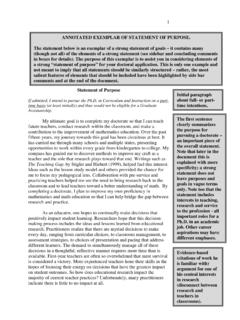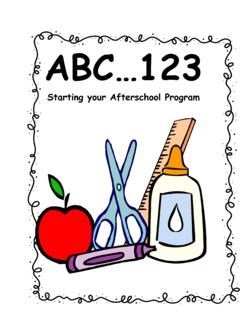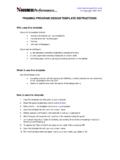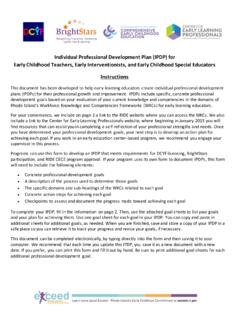Transcription of Co-teaching Part 2: A more in depth examination of co ...
1 Co-teaching Part 2: A more in- depth examination of co-planning and evaluating Co-teaching Kimberly McDuffie Landrum, Education Consultant Academic and Behavior Response to Intervention (ABRI) Project University of Louisville Agenda Overview of definition and models Co-planning Types of co-planning Template Effective components of a lesson Evaluating Co-teaching Critical Elements What administrators should ask for, look for, and listen for Introductions: Poll Question #1 Please let me know if you are a A: Special education teacher B: General education teacher C: Administrator D: Paraprofessional E: Pre-service Teacher (including undergraduate students, MAT graduate students, and student teachers) F: Other Poll Question #2: How much experience do you have with Co-teaching ?
2 A: None B: 1-2 years C: 3-5 years D: 5+ years Definition of Co-teaching Co-teaching occurs when two or more professionals jointly deliver substantive instruction to a diverse, or blended, group of students in a single physical space (Cook & Friend, 1995, ) Co-teaching is when two or more educators co-plan, co-instruct, and co-assess a group of students with diverse needs in the same general education classroom (Murawski, 2003, p. 10) Co-teaching Models Lead and Support One Teaching~One Observing One Teaching~One Drifting Station Teaching Parallel Teaching Alternative Teaching Team Teaching Poll Question #3 Do you need me to provide a more thorough description of the models?
3 A: Yes B: No (majority wins!) Co-planning Why co-plan? Parity To ensure all students needs are being met To establish roles Differentiated instruction Effective grouping Effective instruction Accommodations Varied instructional practices Scheduling a Time to Co-plan Common planning periods Scheduled meetings Sub/administrator coverage Student Activities School assemblies Release from duties (bus duty, lunch duty, etc) Use of technology (Friend, 2008; Murawski, 2009) Types of planning Macro-planning time/Long range co-planning High quality planning time which can last for several weeks Fill in with on the fly planning (lunch time, e-mail; in between classes, etc.)
4 (Friend, 2008) Traditional Planning Long-range co-planning Overall plan for the semester/year Goals for the year (curriculum guide) IEPs goals Accommodations and modifications Student characteristics (Friend, 2008; Murawski, 2009) Traditional planning cont. Short-range co-planning Have and keep an agenda Use time wisely Start with big picture items Discuss individual students Don t recreate the wheel (Murawski, 2009) Traditional Co-planning cont. Step 1: Select Content Including the objective of the lesson Step 2: Determine teaching process or instructional strategies that will be used Will that differ for some students?
5 Step 3: Determine how you will assess students achievement towards the objective Formally vs. informally Step 4: Determine teacher roles and models that will be used Murawski, 2009 Traditional Co-planning cont. Before the meeting GE teachers gathers key information about upcoming curriculum, projects and activities, etc. During the meeting Decide which Co-teaching models will be used, how to group students, and which aspects of instruction may need to adapted. Individual student matters are discussed Decide on roles during the lessons. After the meeting SE teacher adapts the instruction to meet the needs of individual students.
6 (Friend, 2008) Sample Co-teaching Lesson Plan Template Activity #1: Warm up Co-teaching Model: Role of General Education Teacher: Role of Special Education Teacher: Role of the Students: Materials: Accommodations Formative Assessment: Activity #2: Co-teaching Model: Role of General Education Teacher: Role of Special Education Teacher: Role of the Students: Materials: Accommodations Formative Assessment: Standard: Objective: Procedures: Activity #3: Closing Activity Co-teaching Model: Role of General Education Teacher: Role of Special Education Teacher: Role of the Students: Materials: Accommodations Formative Assessment: Summative Assessment Basis for Selecting a Co-teaching Approach Student characteristics and needs.
7 Teacher characteristics and needs. Curriculum, including content and instructional strategies. Pragmatic considerations Sample Co-Planning Templates The Co-teaching Manual Basso and McCoy (2009) Co-teaching lesson plan- daily Co-teaching lesson plan weekly The Co-teaching Lesson Plan Book Dieker (2006) Effective Co-teaching Practices Differentiated instruction requires teachers to respond to student needs through Quality curriculum Respectful tasks Flexible grouping (including homogenous grouping) Continuous assessment Building community (Tomlinson, 1999) Content Process Product According to Students Readiness Interest Learning Profile Teachers Can Differentiate Adapted from The Differentiated Classroom: Responding to the Needs of All Learners (Tomlinson, 1999).
8 Environment Differentiating by Content Defined as: What the student needs to learn. The instructional concepts should be broad based, and all students should be given access to the same core content. However, the content s complexity should be adapted to students learner profiles. Teachers can vary the presentation of content,( , textbooks, lecture, demonstrations, taped texts) to best meet students needs. (CEC, 2001) Examples: Using reading materials at varying readability levels Putting text materials on tape Using spelling or vocabulary lists at readiness levels of students Meeting with small groups to re-teach an idea or skill for struggling learners, or to extend the thinking or skills of advanced learners.
9 Differentiating by Process Defined as: Activities in which the student engages to make sense of or master the content. Examples of differentiating process activities include scaffolding, flexible grouping, interest centers, manipulatives, varying the length of time for a student to master content, and encouraging an advanced learner to pursue a topic in greater depth . (CEC, 2011) Examples: Using tiered activities Learning Centers Visual and/or auditory prompts Peer tutor Use of Graphic Organizers, Learning Strategies, Mnemonics, and Manipulatives Differentiating by Product Defined as: The culminating projects that ask students to apply and extend what they have learned.
10 Products should provide students with different ways to demonstrate their knowledge as well as various levels of difficulty, group or individual work, and various means of scoring. (CEC, 2011) Examples: Giving students options of how to express required learning ( , create a puppet show, write a letter, or develop a mural with labels); Using rubrics that match and extend students' varied skills levels; Allowing students to work alone or in small groups on their products; and Written report vs. oral report Modified test Use of a word processor Differentiating by Environment Defined as: The way the classroom works and feels.



















